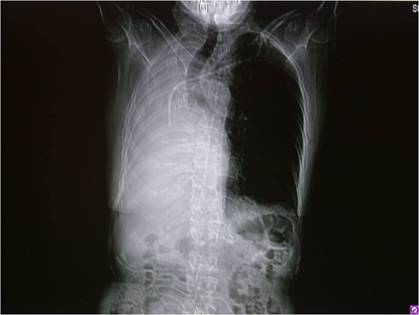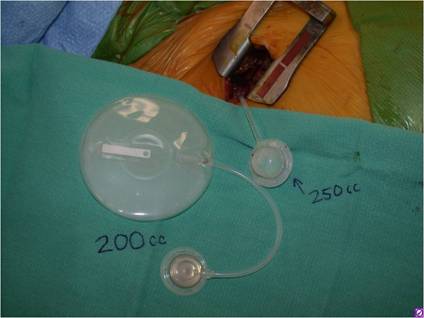Friday, October 31, 2008
14618
Minimally Invasive Intrapleural Tissue Expander Placement In the Management Of Adult Post-Pneumonectomy Syndrome
Purpose: Although rare, pneumonectomy may result in severe, late term mediastinal shift, bronchial obstruction, respiratory failure, and eventual death collectively termed Post-Pneumonectomy Syndrome (PPS).1 Historically, a variety of treatments, such as muscle-flap transposition, pericardial fixation, phrenectomy, filling of the empty hemithorax with saline/ albumin, and endoscopic bronchial stent insertion have been utilized to restore intrapleural dimension. While these approaches have met with mild success, they have generally been employed in children due to the higher incidence of PPS in this particular population. 2 Management of this complex problem in the adult population has only rarely been described, and no current consensus exists on an optimal approach.3 Here, we describe placement of tissue expanders within the empty intrapleural space to restore hemithoracic volume, decompress the remaining bronchus, and substantially improve respiratory function. Method: A 78 year old female who previously had undergone a right pneumonectomy followed with radiation therapy for stage IIIA non-small cell carcinoma developed postpneumonectomy syndrome with mediastinal shift. The patient developed a progressive shift of the mediastinum to the right hemithorax with significant narrowing of the left mainstem bronchus causing dyspnea and stridor. Fig. 1 A right anterior minithoracotomy just lateral to the pectoralis major muscle in the third intercostal space was performed. The pleural cavity measured 9cm transversely to 7cm vertically. Two round rigid base expanders 250ml and 200ml were positioned in the right pneumonectomy cavity with the rigid back towards the bony thorax. Fig. 2 These were expanded to 240ml and 180ml along with methylene blue and radiopaque fluid. The injectable ports were brought out and secured onto the underlying pectoralis major muscle. The expandable prosthesis filled the right hemithorax without any hemodynamic compromise. Results: The patient had immediate postoperative relief of stridor along with radiographic evidence demonstrating an improvement of her right mediastinal shift. She was discharged on postoperative day 5 and her dyspnea has improved significantly. Fig. 3 Conclusion: Pneumonectomy can, in rare cases, progress to a severe and life-threatening condition (PPS) resulting from obstruction of residual bronchial structure. In our experience, intrapleural placement of an expandable prosthesis using minimally invasive access allowed for progressive mediastinal recentering, decompression of remaining bronchial structure, and restoration of respiratory function. Adequate intraoperative measurement of the hemithoracic cavity is essential in establishing the size and possible use of more than one tissue expander. Relative to more invasive procedures, such as pedicled flap use or aortic arch repositioning, using a minithoracotomy for prosthetic application provided a minimally invasive approach and negated more challenging operative techniques that could have led to higher morbidity risk in the present case. In our experience, TE placement proved the most conservative, effective means of solving this challenging problem.
Figures
Fig. 1 Preoperative AP CXR demonstrating a right mediastinal shift following right pneumonectomy.

Fig. 2 Right minithoracotomy with two round rigid back expandable prosthesis.

Fig. 3 Postoperative AP CXR demonstrating an improvement of previous right mediastinal shift.

References
- Grillo H, Shepard J, Mathisen D, Kanarek D. Post-pneumonectomy syndrome. Diagnosis, management and results. Ann Thorac Surg. 1992;54:638-51
- Rash DK, Grover FL, Schnapf BM, Clarke E, Pollard TG. Right pneumonectomy syndrome in infancy treated with an expandable prosthesis. Ann Thorac Surg. 1990;50:127-9
- Audry G, Balquet P, Vazquez MP, Sorrel Dejerine E, Baculard A, Boulé M, et al. Expandable prosthesis in right postpneumonectomy syndrome in childhood and adolescence. Ann Thorac Surg. 1993;56:323-7
